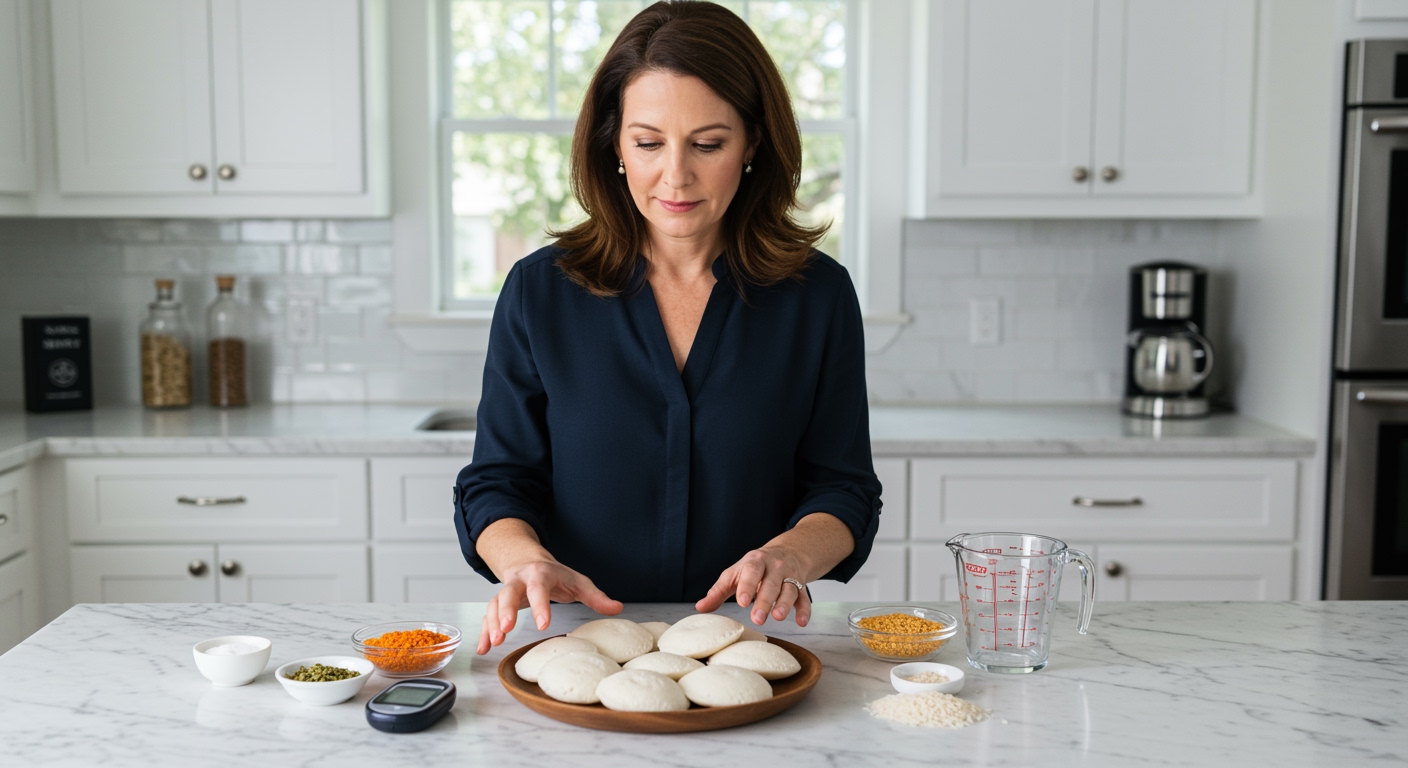✪ Key Takeaway: Idli can be good for diabetes when eaten in moderation due to fermentation benefits, but portion control matters most.
Introduction
Your grandmother swears by idli for breakfast, but your doctor warns about carbs and blood sugar spikes.
You might be asking this question because you love this fluffy South Indian staple but worry about how it affects your diabetes management.
Hi, I’m Abdur, your nutrition coach and today I’m going to explain exactly how idli impacts your blood sugar and whether you can safely include it in your diabetes meal plan.
What Makes Idli Different From Regular Rice?
Idli undergoes a unique fermentation process that changes its nutritional profile completely.
During fermentation, beneficial bacteria break down complex carbohydrates and proteins into simpler forms.
This process creates probiotics that support gut health and may help with better glucose metabolism.
The fermentation also reduces the glycemic index compared to plain cooked rice.
Research shows fermented foods can improve insulin sensitivity in some people with diabetes.
However, idli still contains significant amounts of carbohydrates that will raise your blood sugar levels.
✪ Fact: Fermentation can reduce the glycemic index of rice by up to 20% compared to regular cooked rice.
How Does Idli Affect Your Blood Sugar?
One medium idli contains approximately 15-20 grams of carbohydrates.
Your body converts these carbs into glucose, which enters your bloodstream within 30-60 minutes of eating.
The glycemic index of idli ranges from 60-70, making it a medium glycemic food.
This means it will cause a moderate rise in blood sugar, not as dramatic as white bread but higher than vegetables.
The protein content from lentils in idli helps slow down glucose absorption slightly.
People with well-controlled diabetes may experience a blood sugar rise of 30-50 mg/dL after eating 2-3 idlis.
Those with poorly controlled diabetes might see spikes of 80-120 mg/dL or more.
✪ Pro Tip: Test your blood sugar 2 hours after eating idli to understand your personal response.
Can You Eat Idli With Diabetes Safely?
Yes, you can eat idli with diabetes, but portion control is absolutely critical.
Limit yourself to 1-2 medium idlis per meal to keep carbohydrate intake manageable.
Pair idli with protein-rich sambar and coconut chutney to slow glucose absorption.
The fiber and protein in sambar help create a more balanced meal that prevents sharp blood sugar spikes.
Eat idli earlier in the day when your insulin sensitivity is typically higher.
Avoid eating idli alone as a snack – always combine it with vegetables or protein.
Consider making idli with mixed grains like adding oats or quinoa to reduce the overall glycemic impact.
✪ Note: People taking diabetes medication should monitor blood sugar closely when adding idli to their meal plan.
What Are The Best Ways To Make Idli Diabetes-Friendly?
Replace half the rice with cauliflower rice or grated vegetables to reduce carb content.
Add more lentils to the batter to increase protein and fiber content.
Use brown rice instead of white rice for additional fiber and nutrients.
Incorporate fenugreek seeds into the batter, as they help improve glucose metabolism.
Make smaller idlis to naturally control portion sizes without feeling deprived.
Steam idli for the recommended time to ensure proper fermentation benefits are retained.
Serve with vegetable-loaded sambar instead of coconut chutney to add more fiber and nutrients.
✪ Pro Tip: Soak the batter ingredients for longer periods to enhance fermentation and reduce glycemic impact.
When Should You Avoid Idli With Diabetes?
Avoid idli when your blood sugar levels are already elevated above 180 mg/dL.
Skip idli during illness or stress when your glucose control is typically more challenging.
Do not eat idli if you have gastroparesis, a diabetes complication that slows stomach emptying.
Avoid idli late at night when your metabolism slows down and glucose clearance is reduced.
People with severe insulin resistance should limit idli consumption to special occasions only.
If you experience consistent blood sugar spikes above 200 mg/dL after eating idli, eliminate it temporarily.
Work with your healthcare provider to determine if idli fits into your individualized meal plan.
✪ Note: Always prioritize your blood sugar control over food preferences when managing diabetes effectively.
The Bottom Line
Idli can be part of a diabetes-friendly diet when consumed mindfully with proper portion control and smart pairing strategies.
The key to managing diabetes is not avoiding foods completely but learning how to include them wisely in your overall meal plan.
I would love to hear about your experience with idli and diabetes management – please share your questions, tips, or feedback in the comments section below.
References
At NutritionCrown, we use quality and credible sources to ensure our content is accurate and trustworthy. Below are the sources referenced in creating this article:
- Fitterfly: Is Idli Good for Diabetes
- January AI: Glycemic Index of Idli
- SugarFit: Idli for Diabetes
- Ultrahuman: How Rice Idli Adds to Hyperglycemia





